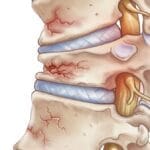Introduction
Frozen shoulder, also known as adhesive capsulitis, is a condition characterized by stiffness and pain in the shoulder joint. It typically progresses through three stages—freezing, frozen, and thawing—each with distinct symptoms and durations. Understanding the pathology, risk factors, and management strategies for frozen shoulder is crucial for effective treatment and recovery.
Pathophysiology
Frozen shoulder is an inflammatory condition affecting the shoulder’s capsule, leading to thickening and tightening around the joint, which restricts movement. The exact cause remains unclear, but it is often associated with systemic conditions such as diabetes, thyroid disorders, cardiovascular disease, and prolonged immobility following surgery or injury.
Stages of Frozen Shoulder
- Freezing Stage: This initial phase, lasting from 2 to 9 months, is marked by pain and progressive loss of motion. Any movement of the shoulder can cause significant discomfort.
- Frozen Stage: Lasting from 4 to 12 months, pain may diminish, but the shoulder becomes stiffer, making daily activities difficult.
- Thawing Stage: Over 5 to 24 months, the shoulder’s mobility gradually improves as the capsule loosens.
Symptoms
Common symptoms include:
- Gradual onset of shoulder pain, often worsening at night.
- Restricted range of motion, making it difficult to perform everyday tasks.
- Stiffness that affects both active and passive movements of the shoulder.
Risk Factors
Several factors can increase the risk of developing frozen shoulder:
- Age and Gender: More common in people over 40, particularly women.
- Systemic Diseases: Conditions like diabetes, thyroid disorders, cardiovascular disease, and Parkinson’s disease.
- Immobility: Keeping the shoulder still for long periods, such as after surgery or an injury.
Diagnosis
Diagnosis is primarily clinical, based on symptoms and physical examination. Imaging tests like X-rays or MRI can be used to rule out other causes of shoulder pain but are not typically necessary for diagnosing frozen shoulder.
Management and Treatment
- Physical Therapy: Gentle stretching and strengthening exercises are essential to restore mobility and reduce pain. A physical therapist can design a specific exercise program tailored to the patient’s needs.
- Medications: Nonsteroidal anti-inflammatory drugs (NSAIDs) and corticosteroid injections can help manage pain and inflammation. Steroid injections may provide significant relief, especially if administered early.
- Hydrodilatation: This procedure involves injecting sterile water into the shoulder joint to stretch the capsule and improve movement.
- Surgical Intervention: In severe cases, arthroscopic surgery may be performed to release the tight capsule. This is usually considered when other treatments fail to provide relief.
FAQs
Q: How long does it take to recover from frozen shoulder? A: Recovery can take from several months to a few years, depending on the stage at which treatment begins and the individual’s response to therapy.
Q: Can frozen shoulder recur? A: While rare, frozen shoulder can recur in the same shoulder or the opposite shoulder.
Q: Is exercise safe for frozen shoulder? A: Yes, but exercises should be done under the guidance of a physical therapist to avoid further injury and ensure proper technique.
Q: What can I do to prevent frozen shoulder? A: Maintain shoulder mobility through regular exercise, especially if you have conditions that increase the risk. If immobilization is necessary, consult a healthcare provider for appropriate exercises to keep the joint flexible.
Conclusion
Frozen shoulder is a challenging condition that can significantly impact daily life. Early diagnosis and a comprehensive management plan involving physical therapy, medications, and possibly surgical intervention are crucial for effective recovery. Understanding the risk factors and preventive measures can help manage and potentially avoid this debilitating condition





